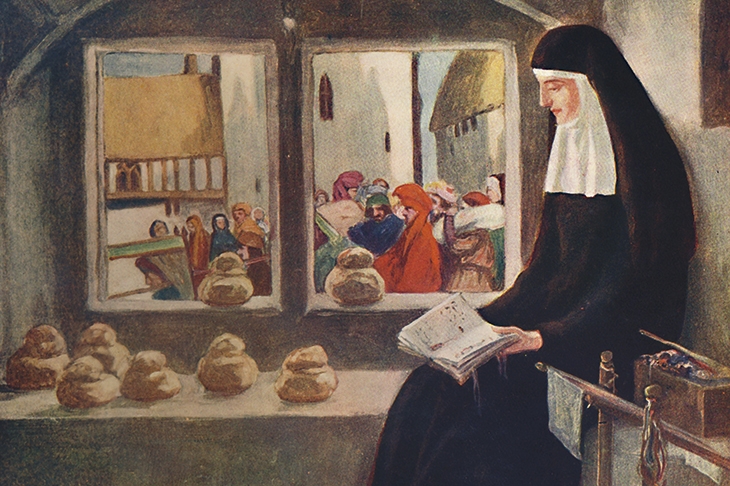Mary Wellesley has narrated this article for you to listen to.
At a time when so many of us are experiencing some measure of isolation, it is hard to fathom the choice to live in extreme confinement in the middle of the urban bustle. But hermits were once unremarkable features of England’s cities.
The 13th-century traveller entering London from the north, at Cripplegate, would have walked within yards of a hermit’s cell. There were also cells at Aldgate, Bishops-gate, Temple Bar and Cornhill, as well as many others beyond the city limits.
These hermits — more properly called anchorites or anchoresses — permanently enclosed themselves in cells attached to churches in order to live a life of prayer and contemplation. (The word comes from the Greek anachorein, meaning ‘to retire or retreat’.) In their cells, anchorites lived a life of extraordinary restriction. They had a small window which looked on to the church, another which led on to a servant’s parlour (through which they could receive food and get rid of waste) and a third on to the churchyard or street, from which they could dispense spiritual counsel. They were otherwise confined to a single room for what could be decades.
Life as an anchorite began with a death. After processing from the church as the choir sang ‘In paradisum deducant te angeli’ — traditionally sung as a body is conveyed to a grave — the recludensus (novice recluse) would arrive at the cell and climb into a ready-dug grave, where they were sprinkled with earth — ashes to ashes, dust to dust — before the door of the cell was bolted. When they died, they would likely be buried in this very grave. Life inside the cell was one of sensory deprivation, with limited light, fresh air, conversation or laughter, and devoid of touch or exercise.
To volunteer for this life is almost un-thinkable now, but there were around 200 anchorites across the country in the 13th century. Women outnumbered men by as much as three to one. Perhaps the most famous English recluse was the anchoress Julian of Norwich, who was enclosed in a cell in the heart of Norwich. In 1373, before she was enclosed, she had a near-death experience which culminated in a series of 15 visions of God. She recovered and lived for around another 40 years. Soon after her experience she composed her Revelations of Divine Love.
The work is important not simply because it is the first in English that we can be certain was authored by a woman, but also because she was a writer of exceptional quality. Her prose is characterised by its elegant rhetorical structure. In spite of this it never feels scholarly or obtuse; instead it is a work of clarity and empathy. Given the privation of her life, the work is strikingly, almost radically, hopeful. She never explicitly refers to her enclosure. At one point she writes that ‘this place is pryson, and this lyfe is pennannce’, but she was likely referring to her life on Earth, rather than the confines of her cell. Her work is instead suffused with optimism, exemplified by her most famous line: ‘All shall be well and all shall be well and all manner of things shall be well.’ Julian’s work is a message of hope in darkness, which speaks to us across the centuries.






Comments